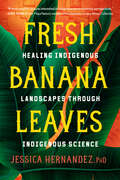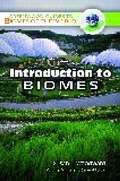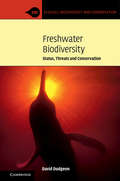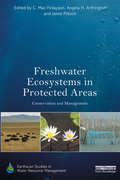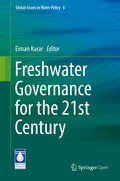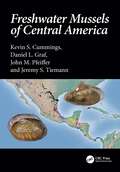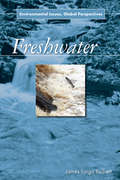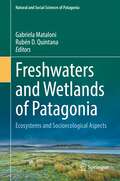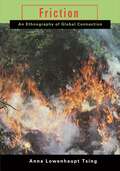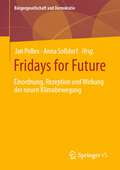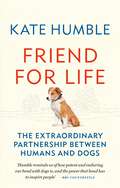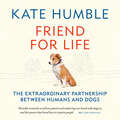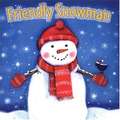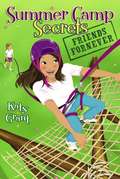- Table View
- List View
Fresh Air, Clean Water: Our Right to a Healthy Environment (Orca Think #4)
by Megan ClendenanKey Selling Points Fresh Air, Clean Water profiles kids taking action on environmental rights around the world and gives young readers an understanding of their right to a healthy environment, how environmental rights are tied to human rights and the tools needed to take action. This is a timely topic, given news coverage of climate protests and youth activists such as Greta Thunberg and Autumn Peltier. Many countries have now protected the right to a healthy environment in their constitutions, and there is discussion at the United Nations about creating a global right to a healthy environment. Introduces critical environmental and social justice questions and connects them to recent history for context. Details environmental rights cases from around the world, many featuring children and youth; for example, from Columbia, the Philippines, the United States and Canada. With her background in environmental activism and social justice, the author is an authoritative guide on this topic. Features full-color illustrations and photos throughout. Free Activity Sheet is available for download at orcabook.com.
Fresh Banana Leaves: Healing Indigenous Landscapes through Indigenous Science
by Jessica HernandezAn Indigenous environmental scientist breaks down why western conservationism isn't working--and offers Indigenous models informed by case studies, personal stories, and family histories that center the voices of Latin American women and land protectors.Despite the undeniable fact that Indigenous communities are among the most affected by climate devastation, Indigenous science is nowhere to be found in mainstream environmental policy or discourse. And while holistic land, water, and forest management practices born from millennia of Indigenous knowledge systems have much to teach all of us, Indigenous science has long been ignored, otherized, or perceived as "soft"--the product of a systematic, centuries-long campaign of racism, colonialism, extractive capitalism, and delegitimization. Here, Jessica Hernandez--Maya Ch'orti' and Zapotec environmental scientist and founder of environmental agency Piña Soul--introduces and contextualizes Indigenous environmental knowledge and proposes a vision of land stewardship that heals rather than displaces, that generates rather than destroys. She breaks down the failures of western-defined conservatism and shares alternatives, citing the restoration work of urban Indigenous people in Seattle; her family's fight against ecoterrorism in Latin America; and holistic land management approaches of Indigenous groups across the continent. Through case studies, historical overviews, and stories that center the voices and lived experiences of Indigenous Latin American women and land protectors, Hernandez makes the case that if we're to recover the health of our planet--for everyone--we need to stop the eco-colonialism ravaging Indigenous lands and restore our relationship with Earth to one of harmony and respect.
Fresh Water and Watersheds
by Yeqiao WangAuthored by world-class scientists and scholars, The Handbook of Natural Resources, Second Edition, is an excellent reference for understanding the consequences of changing natural resources to the degradation of ecological integrity and the sustainability of life. Based on the content of the bestselling and CHOICE-awarded Encyclopedia of Natural Resources, this new edition demonstrates the major challenges that the society is facing for the sustainability of all well-being on the planet Earth. The experience, evidence, methods, and models used in studying natural resources are presented in six stand-alone volumes, arranged along the main systems of land, water, and air. It reviews state-of-the-art knowledge, highlights advances made in different areas, and provides guidance for the appropriate use of remote sensing and geospatial data with field-based measurements in the study of natural resources. Volume 4, Fresh Water and Watersheds, covers fresh water and watersheds, their health and conservation, protection, and management. Organized for ease of reference, it provides fundamental information on groundwater storage, water quality, supply and balance, and water resource vulnerability. New in this edition are discussions on water footprint assessment, water surface dynamics, and water management on a global scale. Understanding the conditions of watersheds is crucial for restoring areas with degraded water quality as well as protecting healthy waters from emerging problems. This volume demonstrates the key processes, methods, and models used through several practical case studies from around the world. Written in an easy-to-reference manner, The Handbook of Natural Resources, Second Edition, as individual volumes or as a complete set, is an essential reading for anyone looking for a deeper understanding of the science and management of natural resources. Public and private libraries, educational and research institutions, scientists, scholars, and resource managers will benefit enormously from this set. Individual volumes and chapters can also be used in a wide variety of both graduate and undergraduate courses in environmental science and natural science at different levels and disciplines, such as biology, geography, earth system science, and ecology.
Fresh-Picked Poetry: A Day at the Farmers' Market
by Michelle SchaubThis collection of poems takes young readers to a day at an urban farmers&’ market. Who to see, what to eat, and how produce is grown—it&’s all so exciting, fresh, and delicious. Readers are invited to peruse the stands and inspect vendors&’ wares with poems like &“Farmer Greg&’s Free-Range Eggs,&” &“Summer Checklist,&” and &“Necessary Mess.&”Bright and vibrant, this is the perfect guide for little ones to take with them on marketing day to inspire literacy and healthy eating.A pleasing window into the world of the farmers&’ market — School Library Journal, starred reviewSprightly illustrations and engaging rhymes will leave readers eager to sample market bounty — Kirkus ReviewsThis cheerful collection of verse offers an enticing introduction to farmers&’ markets — Booklist
Freshwater Aquatic Biomes (Greenwood Guides to Biomes of the World)
by Richard A. RothFor middle and high school students and undergraduates, Woodward, editor of the biomes series and former professor of biogeography and physical geography at Radford U., presents an introduction to biomes. She discusses the concept of the biome and other geographic trends exhibited by life, including taxonomic and evolutionary patterns, related ecological concepts such as ecosystems and soils, and environmental factors that affect the nature of terrestrial and aquatic biomes at the global scale. Use of scientific terminology is minimized. Annotation ©2009 Book News, Inc., Portland, OR (booknews.com)
Freshwater Biodiversity: Status, Threats and Conservation (Ecology, Biodiversity and Conservation)
by David DudgeonGrowing human populations and higher demands for water impose increasing impacts and stresses upon freshwater biodiversity. Their combined effects have made these animals more endangered than their terrestrial and marine counterparts. Overuse and contamination of water, overexploitation and overfishing, introduction of alien species, and alteration of natural flow regimes have led to a 'great thinning' and declines in abundance of freshwater animals, a 'great shrinking' in body size with reductions in large species, and a 'great mixing' whereby the spread of introduced species has tended to homogenize previously dissimilar communities in different parts of the world. Climate change and warming temperatures will alter global water availability, and exacerbate the other threat factors. What conservation action is needed to halt or reverse these trends, and preserve freshwater biodiversity in a rapidly changing world? This book offers the tools and approaches that can be deployed to help conserve freshwater biodiversity.
Freshwater Challenges of South Africa and its Upper Vaal River
by Anja Du PlessisThis book promotes better understanding and awareness of South Africa' significant water problems by describing the country's and especially the Vaal River's water resources. It is a "go-to" book for students, professionals and regular citizens when information is required regarding the country's and more specifically the Vaal River's freshwater resources. It highlights the major problems and risks which need to be addressed and give a realistic and true representation of the current water affairs.
Freshwater Ecosystems in Protected Areas: Conservation and Management (Earthscan Studies in Water Resource Management)
by Angela H. Arthington Jamie Pittock C. Max FinlaysonFreshwater ecosystems have the greatest species diversity per unit area and many endangered species. This book shows that, rather than being a marginal part of terrestrial protected area management, freshwater conservation is central to sustaining biodiversity. It focuses on better practices for conserving inland aquatic ecosystems in protected areas, including rivers, wetlands, peatlands, other freshwater and brackish ecosystems, and estuaries. The authors define inland aquatic ecosystems, showing just how diverse and widespread they are. They examine the principles and processes that are essential for the conservation of freshwater ecosystems and aquatic species. Major categories of threats to freshwater ecosystems and the flow-on implications for protected area design are described. Practical case studies are used to illustrate principles and practices applied around the world. Specific management needs of the main types of freshwater ecosystems are considered, as well as the management of freshwaters in the broader landscape, showing how natural resource governance processes can be harnessed to better manage freshwater biodiversity. The book offers commentary on how to adapt freshwater conservation practices to climate change and ends with an insightful synthesis.
Freshwater Game Fish of North America: An Illustrated Guide
by Peter G. ThompsonThis book is a magnificently illustrated volume that will help anglers, scientists, and nature lovers to identify and appreciate North American freshwater game fish. Along with illustrations that showcase gender color variations for each species, Thompson provides information about fish biology, behavior, and habitats. Common and scientific names are provided, as are range maps and information about each fish family's global range, physical traits, diet, significance to humans, and present status regarding its potential endangerment.
Freshwater Governance for the 21st Century
by Eiman KararThe objective of this book is to broadly illustrate the key aspects of water governance, mapping the spectrum of decision-making from techno-centric and eco-centric approaches, to hybrid concepts and people-centric approaches. Topics covered include the challenges for water-governance models, the polycentric model, the integration challenge, water in the decision-making hierarchy, and the rise of water-sensitive design, while also taking into account interdependencies between stakeholders, as well as the issue of scale. The book's content is presented in an integrated and comprehensive format, building on detailed case studies from around the world and the authors' working experiences in the water sector. Combining essential insights with accessible, non-technical language, it offers a valuable resource for academics, technicians and policy-makers alike.
Freshwater Mussels of Central America
by Kevin S. Cummings Daniel L. Graf John M. Pfeiffer Jeremy S. TiemannThis book describes a fauna of global conservation concern and provides a framework for researchers to begin to test hypotheses regarding the evolution of freshwater mussels in Central America. Placing the Central American fauna in context with that of North and South America, the authors fill a gap in our knowledge of this endangered and largely endemic fauna. This book: Provides a full‑color treatment of all 81 native and introduced freshwater mussel species found from the Río Grande in Texas, USA, and México to Colombia, South America Includes 110 distribution maps of all species Presents complete synonymies in every systematic species account Offers historical information and bios of previous workers in the field Cites complete literature and references on freshwater mussels in the region Through photographs, distribution maps, and a complete list of species described and reported from Central America, Freshwater Mussels of Central America will inspire researchers to begin filling in the gaps regarding the systematics and ecology of freshwater mussels in Central America. It will be an essential source for conservationists, aquatic biologists, and those interested in the natural history of temperate and tropical freshwater ecosystems.
Freshwater Politics in Canada
by Peter ClancyFreshwater is in great supply across much of Canada. However, competing and changing demands on its use are leading to ever more complex political arrangements. This volume offers an integrated survey of that complexity, combining historical and contemporary cases in a conceptually-informed exploration of water politics. It offers a set of tools, frameworks, and applications that enable readers to recognize and explore the political dimensions of freshwater. The opening chapters introduce core concepts such as power, organized interests, knowledge systems, and the state. They are followed by chapters discussing freshwater subsectors including fisheries, irrigation, flood control, hydropower, and groundwater. A series of topical themes is addressed, including salmon conservation, Aboriginal water interests, hydraulic fracturing, regulatory revisions, and interjurisdictional management. A final section explores emerging trends in freshwater governance. While river catchments are not always the principal denominator in discussions of water politics, they do provide a primary frame of reference for this book. A watershed case study accompanies each chapter. This watershed grounding is intended to encourage readers to turn their attention to local and regional conditions.
Freshwater habitats : life in freshwater ecosystems
by Laurie ToupinA look at the plants, animals, locations, and various habitats that make up the freshwater ecosystems of the world.
Freshwater: Environmental Issues, Global Perspectives
by James Fargo BalliettFreshwater is our planet’s most precious resource, and also the least conserved. Freshwater makes up only 3 percent of the total water on the planet, and yet the majority (1.9 percent) is held in a frozen state in glaciers, icebergs, and polar ice fields. This leaves approximately one-half of 1 percent of the total volume of water on the planet as freshwater available in liquid form. This book traces the complex history of the steady growth of humankind’s water consumption, which today reaches some 9.7 quadrillion gallons per year. Along with a larger population has come the need for more drinking water, larger farms requiring extensive irrigation, and more freshwater to support business and industry. At the same time, such developments have led to increased water pollution. Three detailed case studies are included. The first looks at massive water systems in locations such as New York City and the efforts required to protect and transport such resources. The second shows how growth has affected freshwater quality in the ecologically unique and geographically isolated Lake Baikal region of eastern Russia. The third examines the success story of the privatized freshwater system in Chile and consider how that country’s water sources are threatened by climate change.
Freshwaters and Wetlands of Patagonia: Ecosystems and Socioecological Aspects (Natural and Social Sciences of Patagonia)
by Gabriela Mataloni Rubén D. QuintanaThe Freshwaters of Patagonia adopts a socioecological approach, in which experts from across Patagonia review recent, scientifically rigorous literature and data of their own, thus synthesizing the current knowledge directly relevant to understand the present state and future trends of icefields, freshwater and wetland ecosystems in this region.The book’s organization into three parts provides a studied and comprehensive view on the patterns and processes of the various ecosystems in Patagonia, and describes the sociological aspects of freshwater ecosystems, as well as characterizes the conservation of the freshwater and wetland ecosystems, in Patagonia. The chapters offer a broad, state-of-the-art overview of the current status of glaciers, freshwater and wetland ecosystems of this region, as well as studies of both local and large scale biodiversity patterns, and study cases of extreme and naturally polluted environments.The volume concludes with the current status of Patagonian freshwaters, and discusses the scientific, legal and administrative tools aimed at their sustainable management within the framework of the UNEP Sustainable Development Goals 2030 Agenda. A broad audience of students, scientists, engineers, environmental managers, and policy makers will be interested in this volume.
Freya of the Seven Isles (The Art of the Novella)
by Joseph ConradThere is a degree of bliss too intense for elation.This little-known novella from one of the masters of the form is so unusual for Joseph Conrad's work in several respects, although not in its exotic maritime setting or its even more exotic prose--it is unusual in that it is one of his very few works to feature a woman as a leading character, and to take the form of a romance.Still, it's a Conradian romance: a sweeping saga set in the Indian Ocean basin, against a turbulent background of barely suppressed hostilities between Dutch and British merchant navies, told by one of Conrad's classically detached narrators. In the end, the unique perspective of the sharply etched character of Freya is one of Conrad's most piercing studies of how the lust for power can drive men to greatness--or its opposite. The Art of The Novella Series Too short to be a novel, too long to be a short story, the novella is generally unrecognized by academics and publishers. Nonetheless, it is a form beloved and practiced by literature's greatest writers. In the Art Of The Novella series, Melville House celebrates this renegade art form and its practitioners with titles that are, in many instances, presented in book form for the first time.
Friction: An Ethnography of Global Connection
by Anna Lowenhaupt TsingWhat the struggle over the Indonesian rainforests can teach us about the social frictions that shape the world around usRubbing two sticks together produces heat and light while one stick alone is just a stick. It is the friction that produces movement, action, and effect. Anthropologist Anna Lowenhaupt Tsing challenges the widespread view that globalization invariably signifies a clash of cultures, developing friction as a metaphor for the diverse and conflicting social interactions that make up our contemporary world.Tsing focuses on the rainforests of Indonesia, where in the 1980s and 1990s capitalist interests increasingly reshaped the landscape not so much through corporate design as through awkward chains of legal and illegal entrepreneurs that wrested the land from previous claimants, creating resources for distant markets. In response, environmental movements arose to defend the rainforests and the communities of people who live in them. Not confined to a village, province, or nation, the social drama of the Indonesian rainforests includes local and national environmentalists, international science, North American investors, advocates for Brazilian rubber tappers, United Nations funding agencies, mountaineers, village elders, and urban students—all drawn into unpredictable, messy misunderstandings, but misunderstandings that sometimes work out.Providing an invaluable portfolio of methods for the study of global interconnections, Friction shows how cultural differences are in the grip of worldly encounter and reveals how much is overlooked in contemporary theories of the global.
Friction: An Ethnography of Global Connection
by Anna Lowenhaupt TsingWhat the struggle over the Indonesian rainforests can teach us about the social frictions that shape the world around usRubbing two sticks together produces heat and light while one stick alone is just a stick. It is the friction that produces movement, action, and effect. Anthropologist Anna Lowenhaupt Tsing challenges the widespread view that globalization invariably signifies a clash of cultures, developing friction as a metaphor for the diverse and conflicting social interactions that make up our contemporary world.Tsing focuses on the rainforests of Indonesia, where in the 1980s and 1990s capitalist interests increasingly reshaped the landscape not so much through corporate design as through awkward chains of legal and illegal entrepreneurs that wrested the land from previous claimants, creating resources for distant markets. In response, environmental movements arose to defend the rainforests and the communities of people who live in them. Not confined to a village, province, or nation, the social drama of the Indonesian rainforests includes local and national environmentalists, international science, North American investors, advocates for Brazilian rubber tappers, United Nations funding agencies, mountaineers, village elders, and urban students—all drawn into unpredictable, messy misunderstandings, but misunderstandings that sometimes work out.Providing an invaluable portfolio of methods for the study of global interconnections, Friction shows how cultural differences are in the grip of worldly encounter and reveals how much is overlooked in contemporary theories of the global.
Fridays for Future: Einordnung, Rezeption und Wirkung der neuen Klimabewegung (Bürgergesellschaft und Demokratie)
by Anna Soßdorf Jan PollexDer Sammelband verfolgt das Ziel, eine erste umfassende Bilanz zur Rezeption und Wirkung der "Fridays for Future"-Bewegung vorzunehmen. Im ersten Teil stellen die Autor*innen in verschiedenen Kapiteln den Stand der sozialwissenschaftlichen Forschung zur Bewegung dar. Im zweiten Teil des Bandes widmen sich die Autor*innen den Wirkungen, die "Fridays for Future" auf unterschiedlichen Dimensionen der Gesellschaft hat. Die Beiträge in diesem Teil gehen der Frage nach, wie die Bewegung u.a. politische Parteien, lokale und regionale Akteure oder auch die Wissenschaft insgesamt beeinflusst hat, bzw. welche Impulse sie setzen konnte.
Friend for Life: The extraordinary partnership between humans and dogs
by Kate Humble'There is one animal that is familiar to all of us, whoever we are, wherever we live''Even if we've never had direct contact with one, we will have seen one, or at the very least, heard one. For those of us who live in the western world it is more than likely that one sleeps in our house, possibly even on our bed. I'm talking of course, of the dog. Yet, this animal, which lives alongside five hundred million of us all over the world - as an invaluable partner and a trusted confidant - presents us with one great unsolved mystery: how did this relationship - the most complex and enduring of any between human and animal - start in the first place?'Kate Humble is a life-long animal lover. Now living on an idyllic farm in Wales, she has achieved her dream of surrounding herself with as many varieties as possible. But, as with many Brits, the dog has always held a special place in her heart. Here, she uses her journey with her sheepdog puppy Teg to frame her examination of this very special relationship. Written with warmth and love, and packed full of stories about rescue dogs, guide dogs, service dogs and medical dogs, this is a must-read for anyone with a four-legged friend.
Friend for Life: The extraordinary partnership between humans and dogs
by Kate Humble'There is one animal that is familiar to all of us, whoever we are, wherever we live''Even if we've never had direct contact with one, we will have seen one, or at the very least, heard one. For those of us who live in the western world it is more than likely that one sleeps in our house, possibly even on our bed. I'm talking of course, of the dog. Yet, this animal, which lives alongside five hundred million of us all over the world - as an invaluable partner and a trusted confidant - presents us with one great unsolved mystery: how did this relationship - the most complex and enduring of any between human and animal - start in the first place?'Kate Humble is a life-long animal lover. Now living on an idyllic farm in Wales, she has achieved her dream of surrounding herself with as many varieties as possible. But, as with many Brits, the dog has always held a special place in her heart. Here, she uses her journey with her sheepdog puppy Teg to frame her examination of this very special relationship. Told with warmth and love, and packed full of stories about rescue dogs, guide dogs, service dogs and medical dogs, this is a must for anyone with a four-legged friend.
Friend for Life: The extraordinary partnership between humans and dogs (Kate Humble)
by Kate Humble'There is one animal that is familiar to all of us, whoever we are, wherever we live''Even if we've never had direct contact with one, we will have seen one, or at the very least, heard one. For those of us who live in the western world it is more than likely that one sleeps in our house, possibly even on our bed. I'm talking of course, of the dog. Yet, this animal, which lives alongside five hundred million of us all over the world - as an invaluable partner and a trusted confidant - presents us with one great unsolved mystery: how did this relationship - the most complex and enduring of any between human and animal - start in the first place?'Kate Humble is a life-long animal lover. Now living on an idyllic farm in Wales, she has achieved her dream of surrounding herself with as many varieties as possible. But, as with many Brits, the dog has always held a special place in her heart. Here, she uses her journey with her sheepdog puppy Teg to frame her examination of this very special relationship. Written with warmth and love, and packed full of stories about rescue dogs, guide dogs, service dogs and medical dogs, this is a must-read for anyone with a four-legged friend.
Friend for Life: The extraordinary partnership between humans and dogs (Kate Humble)
by Kate Humble'There is one animal that is familiar to all of us, whoever we are, wherever we live''Even if we've never had direct contact with one, we will have seen one, or at the very least, heard one. For those of us who live in the western world it is more than likely that one sleeps in our house, possibly even on our bed. I'm talking of course, of the dog. Yet, this animal, which lives alongside five hundred million of us all over the world - as an invaluable partner and a trusted confidant - presents us with one great unsolved mystery: how did this relationship - the most complex and enduring of any between human and animal - start in the first place?'Kate Humble is a life-long animal lover. Now living on an idyllic farm in Wales, she has achieved her dream of surrounding herself with as many varieties as possible. But, as with many Brits, the dog has always held a special place in her heart. Here, she uses her journey with her sheepdog puppy Teg to frame her examination of this very special relationship. Written with warmth and love, and packed full of stories about rescue dogs, guide dogs, service dogs and medical dogs, this is a must-read for anyone with a four-legged friend.
Friendly Snowman
by Catherine ShoolbredFor the littlest readers - a Christmas board book with a twinkly cover. In FRIENDLY SNOWMAN, it's cold outside, and snow is falling softly. Three rosy-cheeked children are building a snowman out of snow and twigs. And when they say goodbye to him, they're sure they see him wave! Picture descriptions present.
Friends Fornever (Summer Camp Secrets #3)
by Katy GrantDear _, I spent the last year counting down the seconds until I could come back to Camp Pine Haven and see my BFF Nicole. Every summer we have together at camp is better than the last! Well, except this year. I don't know what's up with Nic, but suddenly I can't say anything right. I thought she'd be happy for me that things at home have gotten better, but it almost seems like she's mad that my life is going so well. Am I losing my best friend? XO, Darcy

